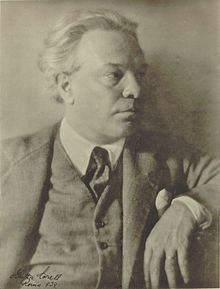Maria egiziaca
| Maria egiziaca | |
|---|---|
| Opera by Ottorino Respighi | |
 Respighi in 1934 | |
| Librettist | Claudio Guastalla |
| Language | Italian |
| Based on | Life of Saint Mary of Egypt |
| Premiere | 10 August 1932 Teatro Goldoni, Venice |
Maria egiziaca (Saint Mary of Egypt) is an opera in one act, in three episodes, by the Italian composer Ottorino Respighi. The libretto, by Claudio Guastalla, is based on a Medieval life of Saint Mary of Egypt, contained in the translation into the vernacular of the Vitae Patrum written by Domenico Cavalca.
The work was originally intended as a concert piece although it has been fully staged in some revivals. It was first performed at Carnegie Hall, New York City, on 16 March 1932. The first stage performance was at the Teatro Goldoni in Venice on 10 August 1932.[1] Both the language of the libretto and the music employ archaism; Respighi's score contains stylistic echoes of Gregorian chant, Renaissance music and Monteverdi.
Roles[]
| Role | Voice type | Premiere cast, 16 March 1932[2] Conductor: Ottorino Respighi |
|---|---|---|
| Maria | soprano | Charlotte Börner |
| Abbate Zosimo (Abbot Zosima)/Pilgrim | baritone | Nelson Eddy |
| Sailor | tenor | Alfredo Tedeschi |
| The leper | tenor | |
| Second companion/Poor man | contralto | Myrtle Leonard |
| First companion/Blind woman/Voice of an angel | soprano | Helen Gleason |
Instrumentation[]
Maria egiziaca is scored for the following instruments:[1]
flute , oboe, 2 clarinets, bassoon, 2 horns, trumpet, 2 trombones, harpsichord (or piano), strings.
Synopsis[]
The prostitute Mary suddenly feels an overwhelming longing to travel to Jerusalem. Here she repents her sins and an angel tells her to go to the desert where she lives in prayer until old age. She is found dying by Saint Zosimas, who digs her grave with the help of a lion.
Recordings[]
| Year | Cast: Maria, Sailor, Pilgrim |
Conductor, opera house and orchestra |
Label[3] |
|---|---|---|---|
| 1980 | Javora Stoilova, Nazzareno Antinori, Carlo Desideri |
, Orchestra and Chorus of Conservatorio di Santa Cecilia (Live recording at Respighi Festival, Assisi) |
CD: Bongiovanni Cat: GL 2008-2 (published 1999) |
| 1989 | Veronika Kincses, Janos Nagy, Lajos Miller |
Lamberto Gardelli, Choir of the Hungarian Radio and Television and Hungarian State Orchestra |
CD: Hungaroton Cat: HCD 31118 |
References[]
- ^ Jump up to: a b "Ottorino Respighi. Catalogo delle composizioni suddiviso per generi musicali: Opere liriche". flaminioonline.it (in Italian). Retrieved 2 January 2015.
- ^ Casaglia, Gherardo (2005). "Maria egiziaca, 16 March 1932". L'Almanacco di Gherardo Casaglia (in Italian).
- ^ Lace, Ian. "Respighi's Maria egiziaca – A story of redemption". musicweb-international.com. Retrieved 9 January 2015.
Further reading[]
- Del Teatro (in Italian)
- Waterhouse, John C. G., "Maria egiziaca", in Holden, Amanda (ed.) (2001), The New Penguin Opera Guide, New York: Penguin Putnam. p. 742. ISBN 0-140-29312-4
- Operas by Ottorino Respighi
- Italian-language operas
- 1932 operas
- One-act operas
- Operas
- Operas set in Egypt
- Operas set in the 5th century
- Cultural depictions of Egyptian women
- Operas based on actual events
- Operas based on real people